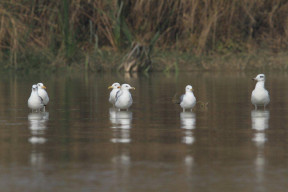
Nangal Wetland
Introduction
Nangal Wetland is a human-made reservoir, which came into existence as a result of the Bhakra-Nangal Project in 1961. The Bhakra-Nangal Dams are among the first river valley multipurpose developmental projects undertaken by India immediately after independence. The Bhakra Dam is constructed across the river Sutlej and at a height of 207.26 m is the second highest dam in India. Some 13 km downstream of the Bhakra Dam, another dam was constructed across the Sutlej near the town of Nangal with the purpose of using it as a backup in case of fluctuation of the Bhakra Dam water levels. The construction of this dam, which is 29 m high and 304.8 m long, has led to the formation of a reservoir, which over the course of time has become a good habitat for wildlife. The surrounding forests are rich in wildlife as it is situated in the highly eco-sensitive Shiwalik foothills and the presence of the reservoir has attracted several resident as well as migratory birds, making it a vibrant wetland. Recognising the ecological significance of the wetland, the Government of Punjab declared the wetland as a Wildlife Sanctuary in 2009. Nangal Sanctuary is a very important and strategic refuelling base for the very long distance/route migratory birds. Species of high conservation significance such as Axis porcinus, Manis crassicaudata, Panthera pardus, Sterna acuticauda, Aythya farina, Aythya nyroca, Ciconia episcopus, Clanga clanga, Neophron percnopterusm, Mycteria leucocephala, Haliaeetus leucoryphus, Python molurus, Ompok pabda, Chitala chitala, Tor putitora, Cirrhinus cirrhosis and Wallago attu have been reported in the Nangal Wetland.
Location
: District Ropar
Access
: Nearest town/city is Nangal.
Latitude
: 31˚ 23’
Longitude
: 76˚ 31’
Altitude
: 362.71m
Notification Detail
Flora
: The main tree species are Acacia nilotica, Cassia fistula, Magnifera indica, Syzygium cuminii, Acacia catechu, Ficus bengalensis, Ficus religiosa, Salix species etc.
Fauna
: 9 species of mammals such as Jungle cat, Mongoose etc., 35 species of fishes, 154 species of migratory as well as resident birds.
Reach Us
Images

×
Historical Importance
The Sanctuary attracts huge tourists as the wetland is not only famous for its wildlife but because of its historic importance. It was on the banks of the Nangal dam that Indian PM Nehru and Chinese PM Chou En Lai formalised the "Panchsheel" or the five Principles of Peaceful Coexistence in 1954.
View of Nangal Wildlife Sanctuary



Close up of Barheaded Goose

Barheaded Goose









